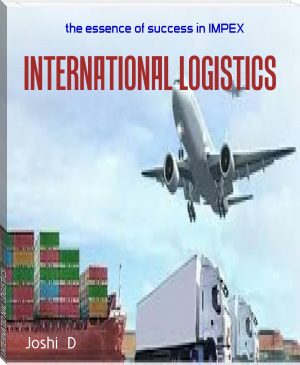Digital Transformation of 3rd Party Logistics by Panthiv Joshi (top romance novels txt) 📕

- Author: Panthiv Joshi
Book online «Digital Transformation of 3rd Party Logistics by Panthiv Joshi (top romance novels txt) 📕». Author Panthiv Joshi
Any logistics technology for 3PLs should include the following:
Integration – Technology should function as a middle-man that helps your different operational systems and units to communicate with one another and perform their individual functions as part of a larger, coordinated effort. Data-Driven Insights – Unifying and standardizing how data is measured across disparate sources (internal and external) in order to accurately understand and optimize your delivery operations cost-effectively. Automation – Automating the delivery flows speeds up processes and creates the flexibility necessary for offering more premium services. Delivery Experience – Shippers rely on their logistics providers to help them offer consignees standout experiences: branded deliveries and branded communications; tracked delivery, consignee feedback, shorter delivery windows, and easier returns. Good delivery orchestration software will make it easier to answer these needs and the costs around them. Dispatcher and Driver Retention – The right 3PL software provides solutions for onboarding, driver data and other tools that increase efficiency and retention rates for drivers and dispatchers.
Doing more, with less......
The relentless focus on customer experience has set a new bar for shippers and delivery providers. Yesterday’s standards for reasonable delivery windows, times and services are no longer enough. Carriers, 3PLs and other providers face an unprecedented challenge, which is also an opportunity: how to take the same levels of flexibility, convenience and speed presented by eCommerce, and translate it into the optimal delivery experience. To compete, providers will need to rethink their technology and adapt their delivery offerings.
Technology Trends That Will Play a Key Role in the Year 2020
Digital Transformation in Logistics: Technology Trends That Will Play a Key Role in the Year 2020
Technology Trends That Will Play a Key Role in The Year 2020
Cloud Logistics :-
The data has shifted to cloud and it is possible to get logistics IT services on-demand or through pay-per-use model. This makes it easy for smaller businesses as they do not have to invest must into creating IT infrastructure and pay for services only when they need it.
For example, Gateway Digital’s system take care of end-to-end logistics processes right from procurement to billing. Most of the supply chain information gets stored on cloud, providing a single overview. Also, as the data processing takes place through cloud, it is easy to access these services. Nearly 50% of logistics owners have adopted cloud logistics and other cloud based services. Another 20% are about to do so.
Big Data and Machine Learning :-
What makes data the most valuable commodity? A lot of reasons. The biggest being, it has the potential to revolutionize business models. In the logistics sector, analyzing and merging data by leveraging AI technology can offer better insights for risk management, demand forecasting and predictive logistics. When data streams containing traffic, weather and shipment information are merged, one can execute real-time route optimization.
Furthermore, big data can transform reactive logistics business models to a predictive one. A model like this, makes use of data received from online vendors to predict sales so that it becomes easier to ship extra orders. It also tracks the shopping habits of customers so that the deliveries can be made smoothly. Such models are used by Amazon to facilitate deliveries on the same day. Remember, nearly 98% third party logistics accept that big data is vital for the success of their organization.
Internet of Things (IoT) :-
When the internet of things is implemented through sensors and connectivity programs, it can connect any object to the internet, providing complete transparency and traceability right from the process of shipping to delivery. Sensors and beacons help in improving customer management and know about the problems that recur at specific route points.
IOT has also been bringing revolution in the logistics industry as one can automate the transportation process and trace the merchandise in the most secure way. Companies like DHL have connected warehouses, so they can tag equipment and individual items providing constant information about their position, operational status etc. making the warehouse processes efficient. IoT connected sensors can monitor humidity and temperature for cargo containing sensitive items like pharmaceuticals and food.
Consumers can avail facilities like IoT push buttons through which they can place an automated order and use smart locks by driving away the issues of unattended home deliveries.
Blockchain :-
Last but not the least, enters blockchain. It can decentralize data by enhancing traceability and transparency and provides users with all the information about a product’s journey. Users can verify if the product they have bought is authentic and is not adulterated or tampered with.
Brands like Walmart make use of blockchain-driven traceability bringing transparency across the entire supply chain. For a lot of logistics companies, Blockchain has simplified intricacies in the system and has led to a 15% increase in global chain along with 5% increase in global GDP.
Coping with Digitization Challenges through Gateway Digital
Companies that have not adopted digital transformation face a lot of challenges due to lack of connectivity. This includes family-run firms as well as global enterprises that have a long delivery chain making it impossible for them to track the delivery process.
Imprint
Publication Date: 10-05-2020
All Rights Reserved
Dedication:
AUTHOR :- Panthiv Joshi panthiv@gmail.com +91 9033077033



Comments (0)